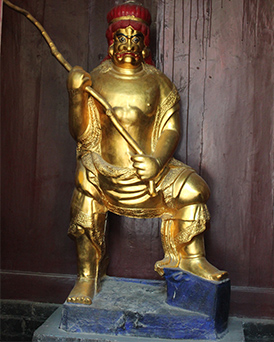Henglin (1865-1923) was a noted Shaolin Kungfu monk and Chan master in the late Qing Dynasty and the early Republic of China. He took tonsure in Shaolin Temple and delved into Kungfu practices. Owing to his proficiency in Kungfu, Henglin was appointed as the instructor of Kungfu monks. In the turmoil of war during the early Republic of China, Henglin led a warrior monk group and defeated bandits in Shaolin areas. He was commended and awarded with medals and inscriptions presented by authorities.
Yuekong was a noted Kungfu monk during the Ming Dynasty. Ancient records show that Shaolin Kungfu monk Yuekong received an official call to fight against pirates in the southeastern coastline. He led a troop of 30-plus warrior monks and defeated a lot pirates, but died in an ambush to save captives taken by pirates. Their story has been written in the history of Shaolin warrior monks’ fight against pirates.
Xiaoshan (1500-1568) was one of great Chan masters during the Ming Dynasty. Before he took the position as Shaolin Abbot, he had studied with previous abbot Yuezhou for eight years and preached Chan Buddhism at numerous monasteries. Xiaoshan was inaugurated as abbot in 1557 by an edict of the imperial court. As the abbot of Shaolin Temple, he presided over large Dharma gatherings to rejuvenate the Caodong School at Shaolin Temple, and also raised funds to renovate the temple and rebuild the First Patriarch Temple. During the fight against pirates in the Ming Dynasty, Shaolin warrior monks dispatched by then Abbot Xiaoshan defeated the pirates at several battles and enjoyed popular acclaim for their victorious achievements. Xiaoshan retreated from his position in 1566 and passed away at age 68 in 1568.

No biographical information on Kinnara is available. One story from ancient Mt. Song records tells that in 1341 an eccentric monk with a stick unexpectedly appeared and then served at the temple kitchen. The monk defended the temple against the attack of the red turbans on March 26, 1351(Yuan Dynasty) and was then found out an incarnation of King Kinnara. Thereafter, Kinnara was revered as the guardian deity of Shaolin Temple. A Kinnara Hall was built and his statue enshrined inside.
Fuyu (1203-1275) was a venerable Chan master of Caodong Sect in the early Yuan Dynasty. In 1245, Fuyu was appointed by the first Emperor of the Yuan Dynasty, Kublai Khan as the abbot of Shaolin Temple before the former took the throne. As the abbot of Shaolin Temple, he introduced Caodong doctrines and brought unprecedented prosperity to the temple. Furthermore, Master Fuyu, it is said, attached great importance to Shaolin Kungfu and made efforts to boost Shaolin Kungfu. He died in 1275 at age 73 and was buried in the Pagoda Forest.
Zhicao, Huichang and Tanzong are famous Kungfu monks at Shaolin Temple during the early Tang Dynasty. According to Shaolin Temple Inscription and another record, in 621AD, the Prince of Qin, Li Shimin, was in battle against Sui General Wang Shichong in the Songshan Moutain region. Headed by Kungfu monks Zhicao, Huichang and Tanzong, thirteen Shaolin monks ambushed the Sui army, captured Wang Shichong's nephew and freed Li Shimin. Li Shimin went on to ascend the throne of Tang Dynasty, and he rewarded the monks with 40 hectares of land and other privileges. He also granted the title of Great General to monk Tanzong and permitted the temple to retain a standing army of warrior monks. This victory quickly gained popularity for Shaolin Temple, and with the patronage of the imperial court Shaolin Temple grew and prospered.

Bodhidharma was from the Brahman caste of South India and honored as the 28th Patriarch of Buddhism. Arriving at Shaolin Temple around 520 AD, Bodhidharma sought to become enlightened. He found a nearby cave and meditated for nine years, constructing the Chan Buddhism philosophy of China. The practice of Mahayana wall-gazing as a type of meditation is ascribed to Bodhidharma and the Lankavatara Sutra is one of the fundamental Chan texts in relation to Bodhidharma. It is said that Bodhidharma was also expert at martial arts and in particular a master of sitting-meditation technique.

Sengchou was born in Julu, Hebei Province and well known as an eminent master during the period between the Northern Wei Dynasty (386-534 AD) and the Northern Qi Dynasty (550-557 AD). He was admitted by Buddhabhadra (or Batuo in Chinese) as a disciple and achieved high-advanced proficiency in Theravada practice or the Low Vehicle. Buddhabhadra praised him as the best student of Buddhist doctrine of all the monks in the vast area east of the Congling Range (modern the Pamir Mountains). Later Sengchou succeed Buddhabhadra to preside over Shaolin Temple. He passed away in 560.